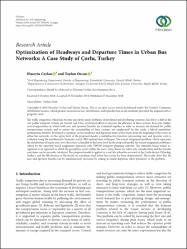| dc.contributor.author | Ceylan, Hüseyin | |
| dc.contributor.author | Özcan, Tayfun | |
| dc.date.accessioned | 2020-11-20T14:50:36Z | |
| dc.date.available | 2020-11-20T14:50:36Z | |
| dc.date.issued | 2018 | |
| dc.identifier.issn | 1687-8086 | |
| dc.identifier.issn | 1687-8094 | |
| dc.identifier.uri | https://doi.org/10.1155/2018/7094504 | |
| dc.identifier.uri | https://hdl.handle.net/20.500.12809/1577 | |
| dc.description | WOS: 000455605500001 | en_US |
| dc.description.abstract | The traffic congestion, which has become one of the major problems of developed and developing countries, has led to a shift in the way public transport systems are viewed, and it has accelerated efforts to increase the efficiency of these systems. In recent studies, several approaches, in which both user and operator benefits are evaluated together in order to increase the demand for public transportation systems and to ensure the sustainability of these systems, are emphasized. In this study, a bilevel simulation/optimization model is developed to optimize service headways and departure times of first buses from the beginning of the routes in urban bus networks. At the upper level of the proposed model, a multiobjective function representing user and operator costs is evaluated using the metaheuristic harmony search (HS) optimization technique. The transit assignment problem, which represents the distribution of transit users over the routes, is handled at the lower level. In the proposed model, the transit assignment problem is solved by the timetable-based assignment approach with VISUM transport planning software. The timetable-based transit assignment is an approach in which the perception errors within the users' route choice are taken into consideration and the transfer wait times can be precisely calculated. The proposed model is applied to a real-life urban bus network of the Corlu district (Tekirda, Turkey), and the effectiveness of the model on a medium-sized urban bus system has been demonstrated. The results show that the user and operator benefits can be simultaneously increased by adding an initial departure offset parameter to the problem. | en_US |
| dc.description.sponsorship | Scientific Research Projects Department of Pamukkale UniversityPamukkale University [2018KRM002-233] | en_US |
| dc.description.sponsorship | The authors gratefully acknowledge the contribution of the PTV Traffic Mobility Logistics for the VISUM traffic planning software. The authors are also grateful to the Metropolitan Municipality of Tekirdag for providing the reference for the background of this paper. This research was supported by Scientific Research Projects Department of Pamukkale University with project no. 2018KRM002-233. | en_US |
| dc.item-language.iso | eng | en_US |
| dc.publisher | Hindawi Ltd | en_US |
| dc.item-rights | info:eu-repo/semantics/openAccess | en_US |
| dc.title | Optimization of Headways and Departure Times in Urban Bus Networks: A Case Study of Corlu, Turkey | en_US |
| dc.item-type | article | en_US |
| dc.contributor.department | MÜ, Yatağan Meslek Yüksekokulu, İnşaat Bölümü | en_US |
| dc.contributor.institutionauthor | Özcan, Tayfun | |
| dc.identifier.doi | 10.1155/2018/7094504 | |
| dc.identifier.volume | 2018 | en_US |
| dc.relation.journal | Advances in Civil Engineering | en_US |
| dc.relation.publicationcategory | Makale - Uluslararası Hakemli Dergi - Kurum Öğretim Elemanı | en_US |


















